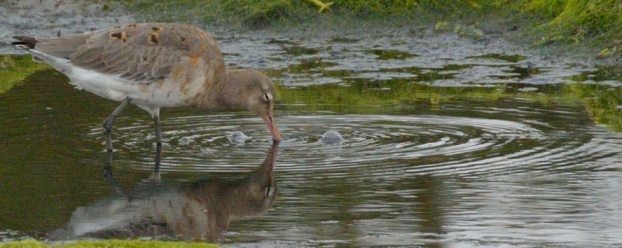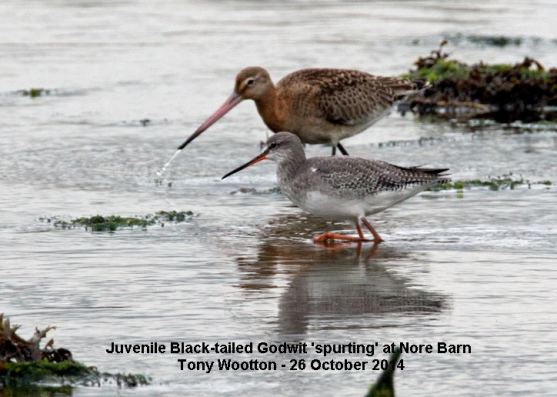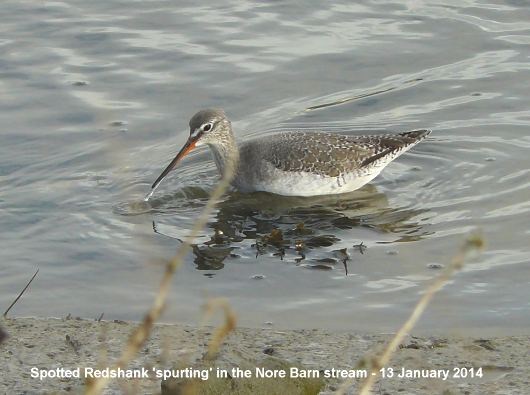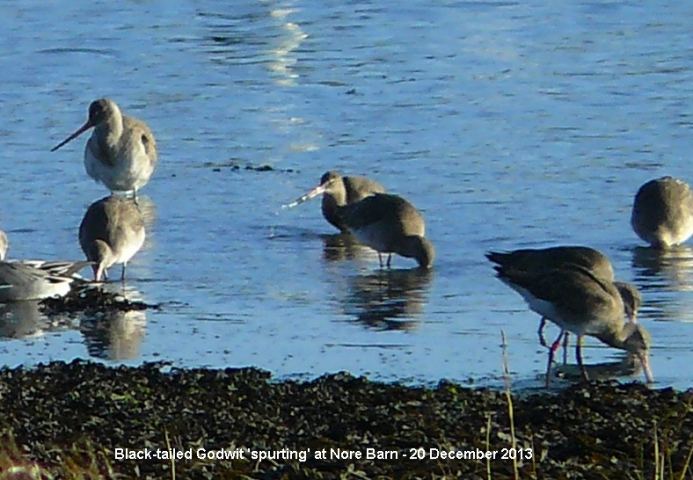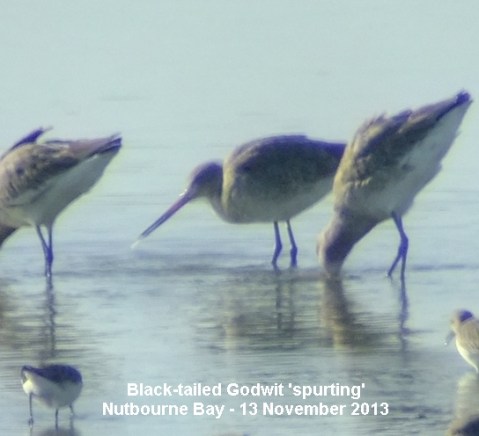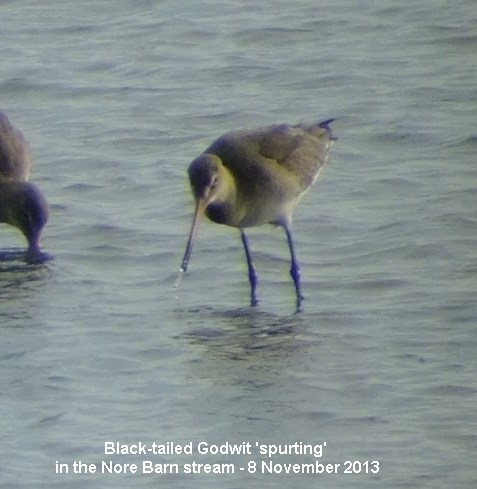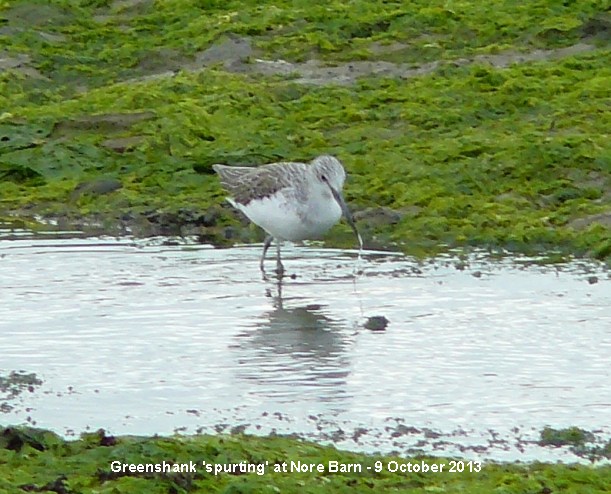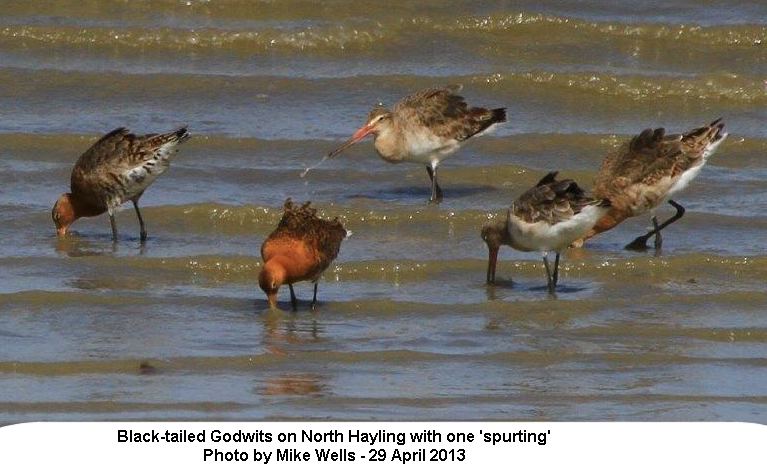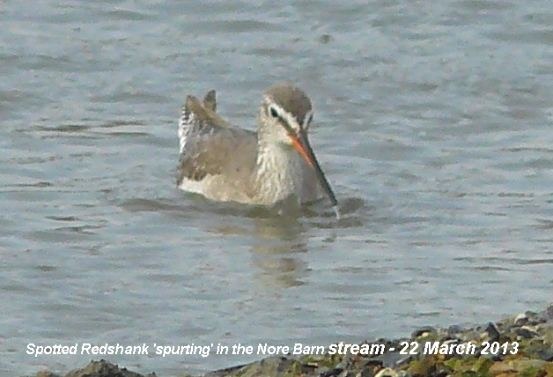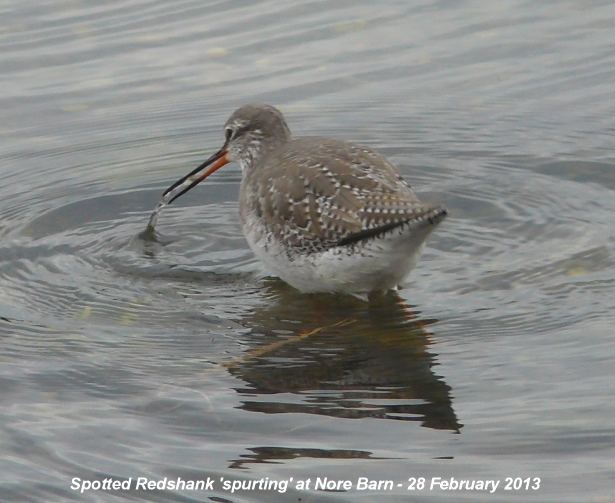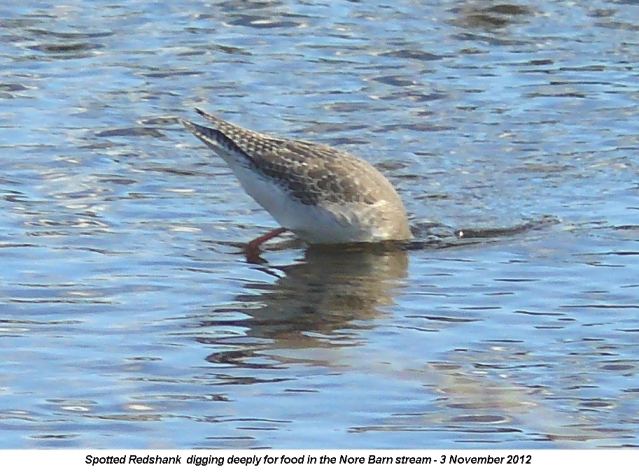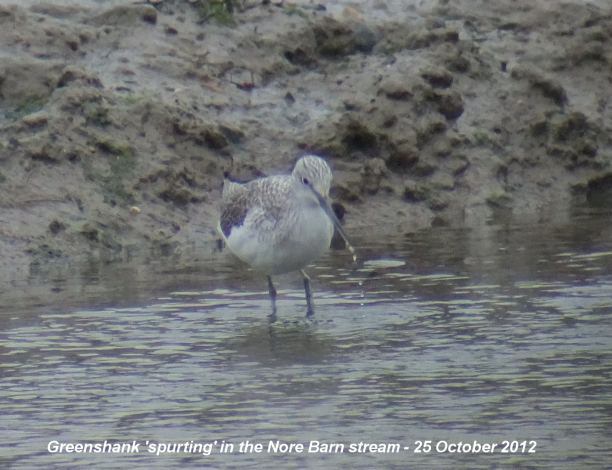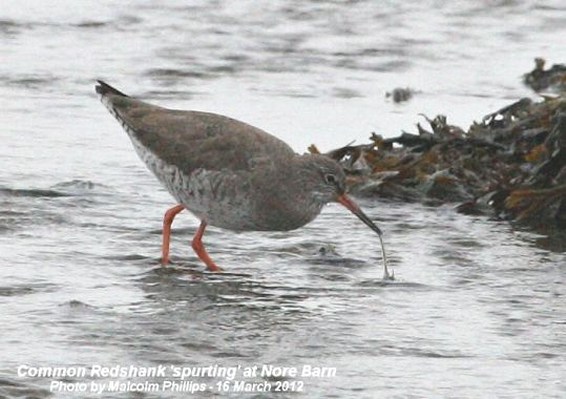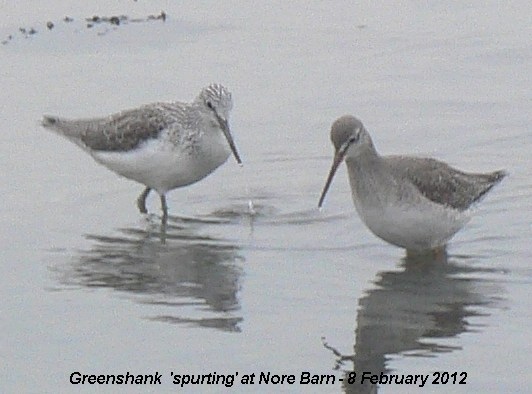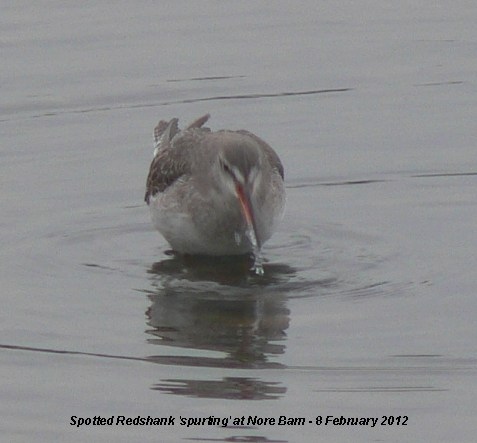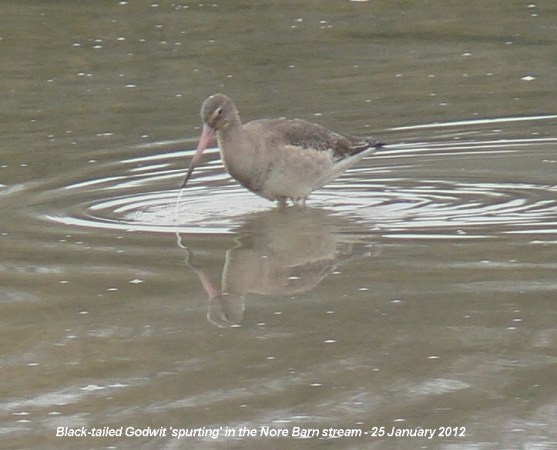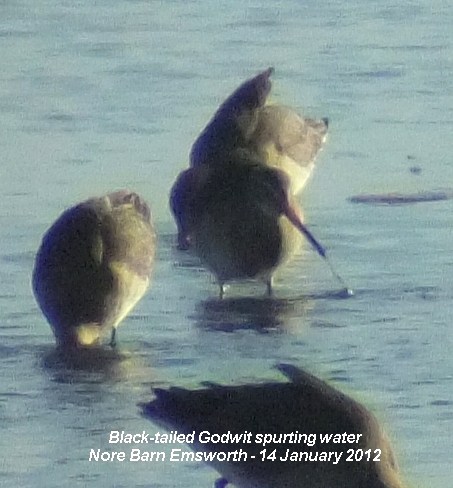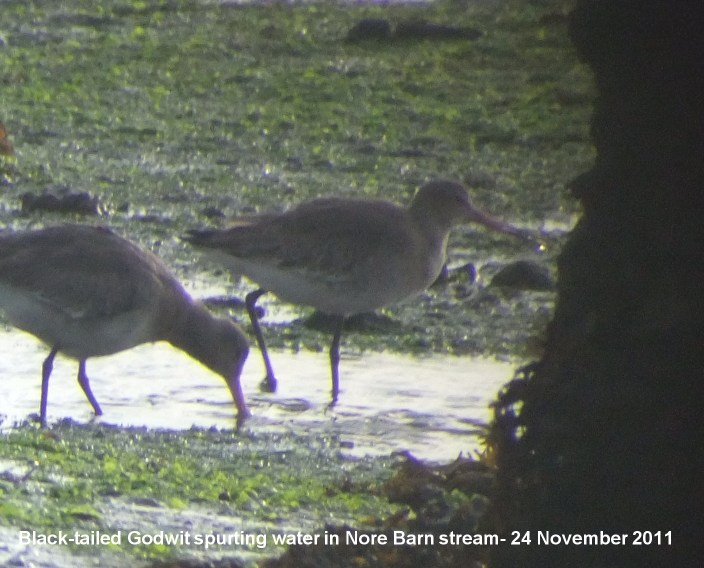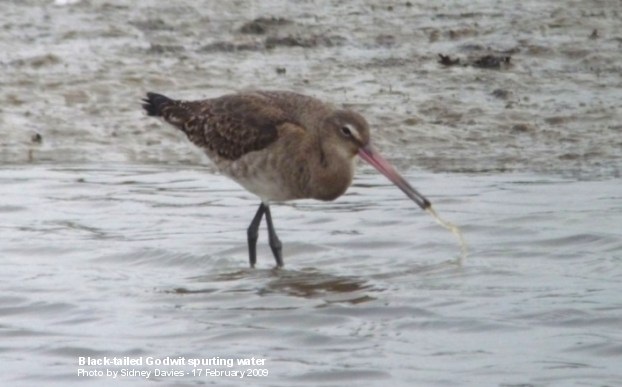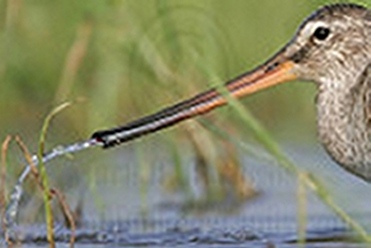RETURN TO . . . Emsworth Wildlife - Homepage
SPURTING BEHAVIOUR' in wadersBackground
Black-tailed Godwits regularly feed in Emsworth Harbour in the winter period - Oct-Mar. I have watched them for many years, mainly logging the colour-ringed birds. From photos (usually digiscoped), I have many examples in which the Godwits appear to be actively spurting water from their bills when feeding.
Roughly, the behaviour is as follows: the bird dips its bill into the water for a couple of seconds, or so, to obtain food. It then withdraws its bill for a moment and pushes foward slightly, usually (though not always) with the bill lowered and 'spurts' out a stream of water, as if ridding itself of surplus taken liquid taken in during the underwater feeding. The bill is then reinserted into the water and the sequence of behaviour is repeated. All this happens very quickly, though video clips I have taken through my scope show the behaviour reasonably well.
The behaviour is not confined to Black-tailed Godwits. I also have photos shown below of Greenshank, Spotted Redshank and Common Redshank all apparently 'spurting'. See below.Mystery behaviour
I consulted various Godwit experts, none of whom had ever seen or heard of it, or knew why it should happen. Pete Potts suggested I should send the photos to Dr Humphrey Sitters, Editor of the Wader Study Group Bulletin, who sent them on to international wader authorities who likewise did not know anything about it either.
Anne de Potier was in Portugal with the Godwit ringing and recording team in February 2012 and asked the assembled crowd whether anybody knew anything about spurting, and Matt Thomas, a wildlife warden from the north west and keen photographer, piped up. Yes! He had pictures taken in August 2011. Anne said none of the assembled, more experienced, people had seen it or heard of it.
Here is the link to Matt's 'blog' - look for 4 August and 24 August 2011. http://deebirder.blogspot.com/2011_08_01_archive.html It is interesting, that on 24 August Matt says he can see worm entrails coming out with the spurting water.Publication
I was surprised that various wader experts I consulted (a) had not seen what seems to me to be fairly common behaviour among Black-tailed Godwits and other waders, or (b) know why it should happen. So, at the request of Humphrey Sitters, the editor of the Wader Study Group Bulletin, I wrote a short article on 'spurting' behaviour with photos. After a very long delay, the article was finally accepted for publication - my very first ornithological publication!
See . . . 'Spurting behaviour in wading birds' . . Published in the Wader Study Group Bulletin Vol 120 (3) 2013 pp 208-209
SPURTING DIARY in reverse chronological orderWEDNESDAY AUGUST 22 - 2018
Godwits 'spurting' and 'bubbling'!
On Monday (Aug 20) Chris Cockburn was taking random photos of Black-tailed Godwits feeding in the HCC Marsh Field from the Hayling Billy Trail north. He says it had to be 'random' because of his AMD vision problem.
The Godwits were frantically feeding on what Chris thinks were Hydrobia species whilst standing in water approximately up to their leg length, thereby necessitating deep probing with their bills. Interestingly, Chris captured one Black-tailed Godwit spurting water from its bill.'Spurting' behaviour in Black-tailed Godwits and other waders was a topic that interested me several years ago. In addition to Black-tailed Godwits I also have observed Greenshank, Spotted Redshank, Common Redshank and even Spoonbill 'spurting'.
I consulted various Godwit experts, none of whom had ever seen or heard of it, or knew why it should happen. Pete Potts suggested I should send the photos to Dr Humphrey Sitters, Editor of the Wader Study Group Bulletin, who sent them on to international wader authorities who likewise did not know anything about it either. Eventually, I was asked to write a paper which was published in this learned ornithological publication.
You can see my sightings, photos and discussion of its function on a special page on this web site at . . . Spurting behaviourToday Chris got another photo of a Black-tailed Godwit this time apparently squirting air or water below the water level creating bubbles. Chris thinks this might be a behaviour to move soft mud and expose Hydrobia sp (or other small prey items). I don't recall having seen this bubbling behaviour. Does anyone else have observations and photos of this unusual behaviour?
FRIDAY October 24 - 2014 - Nore Barn
Tony Wootton paid a visit to Nore Barn and captured the Spotted Redshank and a juvenile Black-tailed Godwit feeding together in the stream.
MONDAY JANUARY 13 - 2014 - Nore Barn
11:15 - 12:15 - The tide was still well in when I got to Nore Barn (high water was at 09:30). The stream was full of water, but the ever faithful Spotted Redshank was present, feeding on the foreshore. This was my first visit to Nore Barn since Christmas, so I was pleased to see it, though most of its 'friends' had gone. I got one shot of it apparently 'spurting' water from its bill.
FRIDAY DECEMBER 20 - 2013 - Nore Barn
86 Black-tailed Godwits at Nore Barn. Lots of 'spurting' was going on while the godwits were feeding in water.
WEDNEDAY NOVEMBER 12 - 2013 - Nutbourne Bay
About 200 Dunlin were busily feeding on the edge of the falling tide along with a few Black-tailed Godwits, which looked as though they were 'spurting' so I took some photos. Sure enough I did capture one bird in the act as shown here.
FRIDAY NOVEMBER 8 - 2013 - NORE BARN
Black-tailed Godwits - 88 flew onto the mudflats in Nore Barn Creek where they fed on the near shore before flying over to the far shore by the saltmarshes. I captured a couple of examples of the Godwits apparently 'spurting' water from their bills.
WEDNESDAY OCTOBER 9 - 2013
One of my photos today at Nore Barn Emsworth showed a Greenshank 'spurting' while feeding in the stream. I have just one other photo showing a Greenshank spurting taken on 08-Feb-12 at Nore Barn.
MONDAY APRIL 29 - 2013
Mike Wells took this photo of a group of Black-tailed Godwits, some in their orange breeding plumage feeding in the 'Texaco Bay' area on North Hayling Of special interest to me is that one of the Godwits is spurting water from its bill.
FRIDAY MARCH 22 - 2013
The Spotted Redshank was feeding very actively in quite deep water in the stream, sometimes immersing almost its whole body under the water. Here is a photo of the bird apparently 'spurting' water from its bill.
THURSDAY FEBRUARY 28 - 2013
When I returned to Nore Barn at about 11:45 the stream was full of water and Spotted Redshank was feeding at the top of the stream near the small bridge. As it was nice and close I took lots of photos. Three of the photos showed the bird apparently spurting out water through its bill. Here is one of them
Friday February 22 - 2013
Peter Milinets-Raby observed a Greenshank at Warblington 'spurting' as it grabbed a big wiggly worm and spurted the water out. Peter added, "I observed the Greenshank at very close quarters and to me all the bird did was force out the water and sand granules that it had taken down with the wiggly flat worm into it's gullet. The Spotted Redshank does the same after feeding for two three minutes, taking in food, sand particles and excess water into the gizzard/gullet and just like regurgitating food for youngsters it spurts out the water and particles it does not want. Just like an Owl or a Shrike with its pellets".
Wednesday December 5 - 2012
On looking through my photos of the Black-tailed Godwits feeding in shallow water at Nore Barn, I found two that showed birds spurting water from their bills. One of the godwits appeared to be spurting objects with the stream of water.Here is a Black-tailed Godwit simply spurting water
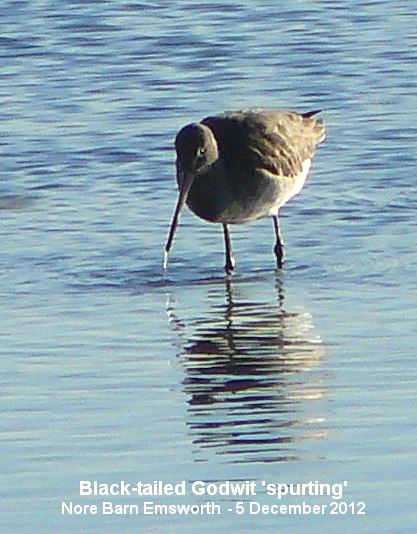
Here is another Black-tailed Godwit spurting objects with the water
Spoonbill 'spurting' (13 December 2002)
Here is an interesting one that I discovered when going through my old photos. It shows the Spoonbill that turned up in Emsworth Harbour in Nov-Dec 2002 apparently spurting water from its bill. This so-called 'spurting' behaviour has been seen numerous times in recent years in Black-tailed Godwits, Greenshank, Spotted Redshank, and other wading birds. It remains a mystery baffling even the ornithological boffins.Spoonbill 'spurting' while feeding in Emsworth Harbour in December 2002
SATURDAY NOVEMBER 3 - 2012
The Spotted Redshank was constantly digging deep in the Nore Barn streamand in one of my photos I discovered that it appeared to be spurting out water from its bill at the end of a feeding episode.
I have previously seen this behaviour mostly in Black-tailed Godwits, but it appears to be also not uncommon in Spotted Redshank and in Common Redshank. The experts are currently puzzling over this behaviour which, very surprisingly, has not been previously recorded.
THURSDAY OCTOBER 25 - 2012
The tide was still well in when I arrived at Nore Barn. I watched the stream gradually empty over the next hour by which time the Little Egret, Greenshank and Spotted Redshank arrived in that order at about 15 minutes intervals. One of my Greenshank photos shows it apparently spurting out water from its bill.
16 March 2012
Malcolm Phillips was at Nore Barn today and got a photo of a Common Redshank apparently 'spurting' water from its bill. This is the first image I have on record of a Redshank 'spurting' to add to those of Black-tailed Godwit, Spotted Redshank and Greenshank. It looks as if this is a general piece of behaviour in wading birds, at least those with fairly long bills.
8 February 2012
Greenshank 'spurting' in the Nore Barn stream.The Spotted Redshank also seems to be spurting in this photo
25 January 2012
Black-tailed Godwit 'spurting'
16 January 2012
I positioned myself in a fairly sheltered place on the path south of the woods in front of the channel where the Godwits gathered as the tide came in. By 14:30, there were 86 in channel, mostly feeding in shallow water. I watched them feeding through the scope and could clearly see water being forcibly spurted from their bills during the feeding process, as if they were ejecting water taken in during the search for food. I took a good number of photos and videos of the Godwits feeding. Here is one for example showing a Godwit apparently 'spurting' water.
13 January 2012
As the Godwits were feeding in water, I took the opportunity to take some photos through the scope to see if there were any cases of water spurting. I could not see the spurting at the time, but there were several clear examples in the photos of what appeared to be water spurting.
I also took a digiscoped video which shows the behaviour of the Godwits feeding. From what I could see the birds dip the bill into the water for a couple of seconds, or so, to obtain food, then withdraw the bill for a moment and push foward slightly with the bill lowered making what looks like a deliberate effort to eject something from the bill. Although the video is not good enough to show it, I think this is when the ejection of water occurs. The bill is then reinserted into the water and the sequence of behaviour is repeated.
24 November 2011
I was interested to watch the Godwits feeding in the stream and saw one bird, at least, distinctly spurting water from its bill. It appeared to be taking food in its bill and then spurting out surplus water. Maybe, this behaviour is related to feeding in a fresh water stream. I think Sid Davies also took his Godwit spurting water in the fresh water canal on West Thorney.This is not such a clear photo of the spurting as I got on October 25, but see the bird on the right
17 November 2011
Experts puzzled over spurting behaviourHumphrey Sitters Editor of the Wader Study Group Bulletin sent photos of the Black-tailed Godwits spurting water from their bills (taken by myself and Sid Davies) to Sora Estrella, of the School of Animal Biology University of Western Australia. Sora has researched waders' use of 'surface tension transport' to transport food along their bills. She did not think the spurts of water in the photos related to the surface tension transport.
Sora Estrella writes: "I'm not sure Black-tailed Godwits have been using surface tension transport in the pictures, or even if they can use the mechanism due to the morphology of their bills. When I have observed shorebirds using STT they have produced only few drops of water, because the water they expel is the drop of water that surrounds the prey, which is a small volume. And sometimes, when they snapped the bills, the water was propelled to all directions."
Humphrey asks of me, "I assume that the photos really do show water being spurted out of the bill and not the bird withdrawing its bill from the water with water flowing off the outside and inside of the bill?" Looking closely at my photo and that of Sid Davies there is no question that the water is coming from the bill itself and not flowing down the outside.Here is my original photo showing two Godwits spurting water
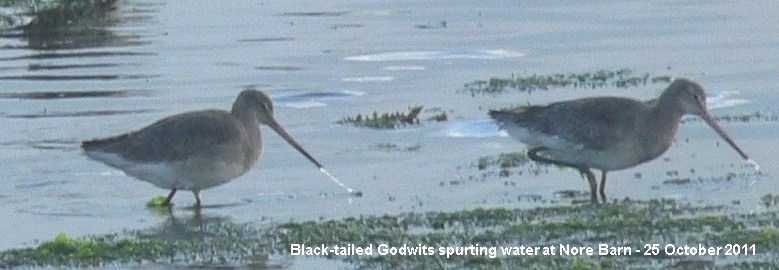
Here is Sid Davies's photo of another Godwit spurting water
Two other observations can be made from the photos which I copy here for convenience.
(a) Firstly, a good quantity of water is being expelled by the Godwits, which, according to Sora Estrella, is far more than they would take in while feeding (or than she herself has observed). So, it seems they are not simply expelling water taken in with the prey they are feeding on, which was my first thought.
(b) Secondly, the water is being forcibly ejected and is not simply dribbling out of the birds bills.Ralph Hollins proposed a solution which went as follows:
"In most cases when probing the mud locates a substantial food item, the bird will pull it out of the mud and ingest it by using its own bill and throat muscles, and any excess water that comes up with the food will drain out of the bird's bill without any danger of losing the food in the process.
If, however, the bird is very hungry but only brings up what seems to be a beakful of water it may try to ensure that it gets any food content out of that beakful of water by first forcing the water out though a minimal gap between the mandibles which allows the water to go but retains tiny food items in the bill (as with a Shoveler duck sieving its food out of the water)."
Another thought offered by Ralph is that the birds were forcibly washing out their bills to get rid of a nasty taste. That might explain why two are doing it together where the great majority are never seen to do it; they could both have been probing the same small nasty tasting patch of mud.
Black-tailed Godwits feeding behaviour
I asked Pete Potts a few questions:
1. How do the Godwits manage to open the shells under the mud?
A: They don't open the shells. They eat the whole shell and crush them in their gizzards.2. Presumably the molluscs are eaten by other waders too?
A: Yes, probably but different waders eat different species and different age classes of bivalves and there is still much to learn.3. There is also a pattern of Godwit feeding in Emsworth Harbour. What I have noticed over the years, is that in July-Sept the Godwits concentrate in the eastern harbour and then move across to the western harbour from Oct onwards. Again, due to food supply I assume?
A: Emsworth Harbour local changes are very interesting; probably just depleting one food supply, then moving on to another rich picking. Is the roost site the same when feeding at each site?
Ralph's explanation of spurting- 3 November 2011
Ralph Hollins provides a detailed explanation of why Black-tailed Godwits might be seen spurting water from their bills. See the discussion and photo on Oct 25.
Ralph points out that the Slybird Blog link gives a good and clear explanation of how minute food items can be ingested with minimum effort by surface tension transport. He thinks the vigourous expelling of water shown in my photo may be a preliminary stage before use of this mechanism.
Link . . . http://slybird.blogspot.com/2007/12/oct-2007-auk-unique-foraging-mechanism.htmlRalph explains: "In most cases when probing the mud locates a substantial food item, the bird will pull it out of the mud and ingest it by using its own bill and throat muscles, and any excess water that comes up with the food will drain out of the bird's bill without any danger of losing the food in the process.
If, however, the bird is very hungry but only brings up what seems to be a beakful of water it may try to ensure that it gets any food content out of that beakful of water by first forcing the water out though a minimal gap between the mandibles which allows the water to go but retains tiny food items in the bill (as with a Shoveler duck sieving its food out of the water).
When almost all the water has gone, the food plus the water left in the bill may be too small a mass for the bill muscles to get a grip on in order to move the food from the bill tip to the throat, and then this use of surface tension to transport the food up the length of the bill from the tip (where it was retained in the filtering out process) by gradually opening the bill, is a clever scheme to move the food uphill to the throat (no problem in then getting the food down the throat).
Pure conjecture but that's my best guess - your water squirting would thus be a necessary stage before the use of surface tension transport."
As suggested by Pete Potts I have sent a note to the editor of the International Wader Study Group Bulletin about this puzzling behaviour.
25 October 2011
It was not until I examined my photos, that I noticed a couple of the Black-tailed Godwits were apparently spurting water from their bills. I have not seen this behaviour before, though it might be explained as a way of ejecting unwanted water taken in with food.Pete Potts said he had never heard of Godwits spurting water from their bills. He thought it might be a world first (!!) and worth a note for International Wader Study Group Bulletin. Anne de Potier discovered a possible answer to the puzzle of what they were doing
It could be due to something called 'prey transport by surface tension of water'. Don't ask me what it means but Anne de Potier provided a good link to an article on it which shows a Hudsonian Godwit seemingly doing exactly the same thing as ours.
http://www.pbase.com/mbb/prey_transport_by_surface_tension_of_water_Googling Surface Tension Transport adds more details, especially
http://slybird.blogspot.com/2007/12/oct-2007-auk-unique-foraging-mechanism.html

